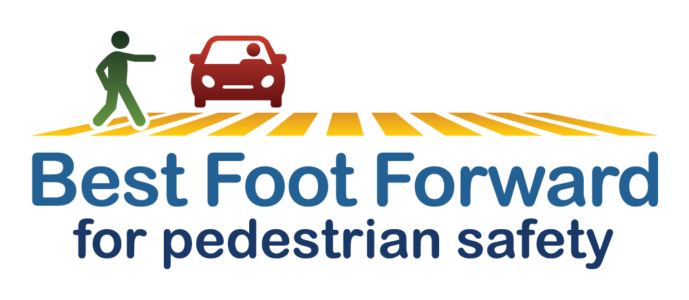Hosted by Bike/Walk Central Florida, the Best Foot Forward (BFF) Summit of 2024 continued its…

Paving the Way Toward Safer Streets: BFF Program Methodology
In the hustle and bustle of Central Florida’s diverse landscape, the quest for safer streets has taken center stage with a shared vision from cities and counties to reduce traffic-related deaths to zero, an initiative coined by the Florida Department of Transportation as Target Zero.
Imagine a community where pedestrians confidently navigate crosswalks, drivers instinctively yield, and the streets resonate with a shared commitment to safety. The Best Foot Forward Program has been paving the way toward this future for over a decade in Central Florida using a comprehensive and evidence-based methodology, which aims to improve pedestrian safety by enhancing driver compliance with crosswalk laws.
Based on a 2013 NHTSA study in Gainesville, FL and a 1998 FDOT/NHTSA study in St. Petersburg, Best Foot Forward utilizes a “triple-E” approach that monitors the effect of high-visibility enforcement, community education, and low-cost engineering on pedestrian safety. The graph below demonstrates how the Gainesville study doubled the average driver yield rate from 31% to 62% at six pedestrian crosswalks throughout 2013. This methodology was developed in part by Dr. Ron Van Houten, who has repeated its success in areas throughout the United States including Ann Arbor, MI and St. Paul, MN in 2018.

Each year, Best Foot Forward gathers with city & county planners, engineers, and enforcement officials to select crosswalks that may be a good fit for evaluation. Factors considered during the selection process can include enforceability, road speeds, crash data, engineering needs, and proximity to pedestrian areas including shopping centers, transit stops, schools, and trails. After selection, BFF data collectors can begin staged crossings at each location to track the rate of drivers that yield to pedestrians.
Measuring Driver Yield Rates
Best Foot Forward uses staged crossings to count how many drivers fail to yield to pedestrians at each program crosswalk, with special emphasis placed on the safety of drivers and the data collectors conducting this research. Before crossing, BFF data collectors measure and mark the distance required for a driver to safely stop based on the speed limit of the road, which is known as the “dilemma zone.” The distance is calculated based on a formula from the Institute of Traffic Engineers, which considers varying factors such as reaction time, safe deceleration rate, and road grade.

Data collectors mark the dilemma zone with flags, cones, or signs leading up to the crosswalk prior to crossing the street. To show intent to cross, one foot is placed in the road onto the marked crosswalk to indicate to drivers that the pedestrian is attempting to cross. Cars that have already entered the dilemma zone are not counted toward the data. While the dilemma zone is very forgiving to drivers, giving them an adequate amount of space to slow down or stop, some vehicles proceed through the crosswalk at high speeds anyway. These cars are recorded as “not yielding.”
Best Foot Forward data collectors complete three sets of 20 crossings at different times throughout the day and then return every other month for 360 total crossings in a year, collecting data from as many as one thousand cars at a single crosswalk. This methodology allows the BFF program to track the average yield rate over time and evaluate the effectiveness of nearby enforcement, education, and engineering interventions.

Tracking Progress
Since 2012, Best Foot Forward has monitored over 300 crosswalks and coordinated almost 700 enforcement details throughout Orange, Osceola, and Seminole Counties. After dozens of engineering countermeasures, 800+ educational presentations and outreach events, and more than 12,000 warnings and citations, data collectors have recorded a steady increase in driver yield rates at program crosswalks over time: starting with just 17% of drivers yielding to pedestrians in 2012, average yield rates at program crosswalks today have risen to nearly 50%.
By combining community engagement, data-driven strategies, and multi-agency collaboration, the Best Foot Forward program has demonstrated measurable progress toward improving pedestrian safety in Central Florida. As other regions seek effective models to enhance road safety, this multifaceted approach serves as a replicable model for creating safer, more walkable communities.




This Post Has 0 Comments